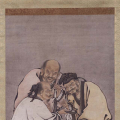Welcome home! Please contact lincoln@icrontic.com if you have any difficulty logging in or using the site. New registrations must be manually approved which may take several days. Can't log in? Try clearing your browser's cookies.
A complete buddhist sutra collection?
 Jeffrey
Veteran
Jeffrey
Veteran


Comments
However, separate from my course, I'm studying the Heart Sutra - out of interest more than anything else (though I hope it to be useful obviously) - and it has a commentary; without which I think I'd be totally lost.
I also understand that the long versions of sutras are for those people with little background knowledge of Buddhism, and the short ones are for those people with a lot of knowledge about Buddhism; since they can fill in the 'gaps' with their knowledge (say Dependant Arising).
So, as I say, how do you guys use Sutras? Do you kinda think, right I want to develop compassion, so I'll study some sutras on compassion?
And do you need to use a commentary?
I personally never read commentaries. If the words of the buddha were conveying something mundane, they would be easily understood (and then of course, quickly analyzed and discarded.) It;s far better to not understand them, than it is to read a commentary and misunderstand them.
These people making commentaries, they always find a simpler, better way of saying what the Buddha meant.... it's also completely incorrect. The Buddha said things with precise purpose, alluding to subtle and deep truths. This is something that no-one gets these days, and immediately gravitate to commentaries by (frankly) 'wisdom by diploma or position' know it alls, who love to make you feel like 'you've got a long way to go before you get to where I am'.
How to use them?
If you feel an affinity to the buddhas sutras, then follow that affinity, wherever that may be. If you aren't thirsty to read something, then it may not be time for it then. That;s how I feel about it. At some point, that thirst may become irresistible, as it has become for me.
Btw thanks for that link!
http://www.accesstoinsight.org/tipitaka/kn/snp/
http://www.bps.lk/olib/wh/wh107.pdf Samyutta Nikaya I
http://www.bps.lk/olib/wh/wh183.pdf Samyutta Nikaya II
http://www.bps.lk/olib/wh/wh318.pdf Samyutta Nikaya III
http://www.bps.lk/olib/wh/wh155.pdf Anguttara Nikaya I
http://www.bps.lk/olib/wh/wh208.pdf Anguttara Nikaya II
http://www.bps.lk/olib/wh/wh238.pdf Anguttara Nikaya III
http://www.metta.lk/tipitaka/2Sutta-Pitaka/2Majjhima-Nikaya/index.html
Majjhima Nikaya (huge)
Digha Nikaya
http://www.dharma.org/bcbs/pages/documents/itivuttaka.pdf
Itivuttaka (short verses)
http://dharmafarer.org/wordpress/wp-content/uploads/2009/12/17.16-Udana-S-s22.55-piya.pdf Udana sutra
http://www.ancient-buddhist-texts.net/Texts-and-Translations/Khuddakapatha/Khuddakapatha.pdf Khuddakapatha
A Complete Buddhist sutra collection???
""" The Tripitaka Koreana (lit. Goryeo Tripitaka) or Palman Daejanggyeong ("Eighty-Thousand Tripitaka") is a Korean collection of the Tripitaka (Buddhist scriptures, and the Sanskrit word for "three baskets"), carved onto 81,258 wooden printing blocks in the 13th century. It is the world's most comprehensive and oldest intact version of Buddhist canon in Hanja script, with no known errors or errata in the 52,382,960 characters which are organized in over 1496 titles and 6568 volumes. """
http://en.wikipedia.org/wiki/Tripitaka_Koreana
And in general, I think that a person should make a really genuine effort to examine and understand a sutra on their own before they seek guidance from a commentary. And if they do seek help from commentary, be very careful as to who you are listening to.
If you guys were thanking me, you're very welcome. I was doing some digging around for myself and thought I'd make them available in case someone wanted them. If there's anything anyone wants let me know.
PERFECT WISDOM: The Short Prajnaparamita Texts
Translated by Edward Conze, 1973. (235pp.)
The_Short_Prajnaparamita_Texts,Conze,1973,1993.djvu (2.0M)
(Prajnaparamita in 700, 500, 150, 50, 25 Lines; in few words; in One Letter; for Kausika; for Five Bodhisattvas. Diamond Sutra. Heart of Prajnaparamita. Questions of Survikrantavikramin; of Nagarsi. 108 Names of Holy Prajnaparamita. 25 Doors to Prajnaparamita.)
http://lirs.ru/lib/conze/The_Short_Prajnaparamita_Texts,Conze,1973,1993.djvu
The Gilgit Manuscript of the ASTADASASAHASRIKAPRAJNAPARAMITA
(Chapters 55 to 70 corresponding to the ABHISAMAYA)
edited and translated by EDWARD CONZE, Roma 1962. (201+212pp.)
http://lirs.ru/lib/conze/AstaDasaSahasrikaPrajnaParamita_ch55-70,Gilgit_MSS,English,Conze,1962.djvu
Materials for a Dictionary of the Prajnaparamita Literature
by Edward Conze, Tokyo 1967, Tokyo 1973. (459pp.)
http://lirs.ru/lib/conze/Materials_for_a_Dictionary_of_The_Prajnaparamita_Literature,Conze,1967,1973,300dpi.pdf
ABHISAMAYALANKARA (SERIE ORIENTALE ROMA VI)
Edward Conze
Introduction and translation from original text with Sanskrit-Tibetan index
http://lirs.ru/lib/conze/Abhisamayalankara,SOR6,Conze,1959.pdf
Buddhist Scriptures
by Edward Conze, 1959. (256pp.)
http://lirs.ru/lib/conze/Buddhist_Scriptures,Conze,1959,1981,html_1.5,zip
(rename file to .zip after you download to unzip.)
Edward Conze
http://www.accesstoinsight.org/lib/authors/conze/wheel065.html
Lots of stuff here, including some short Bodhidharma texts worth looking at
http://www.lapislazulitexts.com/translations.html a few here.
THE MAHAVASTU VOLUME I
Translated from the Buddhist Sanskrit
By J. J. JONES, M.A. (Wales)
http://ia600303.us.archive.org/31/items/sacredbooksofbud16londuoft/sacredbooksofbud16londuoft.pdf and the text version:
http://www.archive.org/stream/sacredbooksofbud16londuoft/sacredbooksofbud16londuoft_djvu.txt
Verses On The Perfection Of Wisdom
Prajnaparamita Ratnagunasamcayagatha
[Translated from the Sanskrit by Edward Conze]
http://lit.lib.ru/img/i/irhin_w_j/prajnaparamita108/ratnagunasamcayagatha.pdf
DR Suzuki's Manual of Zen Buddhism
http://bud_info.republika.pl/zen_manual.pdf
Nagarjuna's Commentary on the Awakening Mind
http://web.mit.edu/metta/www/readings/Bodhicittavivarana_English.pdf
take care all! good reading and have a nice winter.
:thumbsup:
heres a non djvu format, for the samdhinirmocana, someone finally put a pdf out there!
@Tosh Sutra or Sutta means Thread --
an excerpt from http://www.accesstoinsight.org/lib/authors/soni/wheel254.html [Maha Mangala Sutta]
"Coming to the last component of the title: originally by the term "sutta" was meant a string or a thread. In fact the word is still used in this sense. Just as beads can be strung together by a thread into a rosary or flowers into a garland, successive arguments can be strung together into a logically brilliant whole, and sections of a story or a sermon can be threaded together to present a good way to practice. The symbolic use of the word "sutta" to mean a discourse is this "threading together."
In English too, the word "thread" has been the symbol of continuity as suggested by the phrase "a thread of thought." As progressive continuity is obvious in a series of logically connected ideas and events in a narrative, it is symbolized by a thread or a sutta. Evidently a knot in the thread represents "a concentrated deep idea" inviting focused attention for its unraveling. Such reflections result in flashes of wisdom and inspiration.
It was in this sense that the thinkers and sages in ancient India used the term "sutta"; also it was in this form that they expressed their thoughts."
I have read something similar to this explanation -- that Buddha Shakyamuni once mentioned that Buddhas of the past also used sutras to preserve meanings, as it is like threading ideas together. The original words are something like
"Just as one may have leaves on a table, the wind may blow and disperse them... but if one has thread the leaves together the wind may blow and they will not be dispersed. Why? because you strung the leaves together with a thread."
So a Sutra [or thread] is actually not that dissimilar to what a thread on this website looks like, only imagine everyone saying something useful and profound with each additional statement. Sutras are like condensed links of wisdom and different traditions focus on different ones. The heart sutra is an incredibly valuable sutra to learn and study. If you are unfamiliar with a particular sutra and have no one to learn it from, It is extremely advisable that you find some commentary that goes along, as the language used then was different, and one word such as "Thus" might express many facets of meaning, and it is good to be able to read the commentary to get a better feel for it. Then, once you have a good foundation of what the meaning is like, study it more and reflect on it from time to time. Just remember the likeness to the musicians instrument; strings not too tight and not too loose, so should be one's mind when reflecting on these things
Dharma is within us all. May all beings know ease
Probably not, but I will say it anyway.
IT's More important to read sutras translated by Cultivated Monastics along with respectable intellecutals that practices Buddhism rather than reading heaps of text from unsecured sources. This spirituality and wisdom we are talking about, alot is at stake here, do you really want to get attached to wrong views?
How do you really know of Buddhism to know what your reading is correct?
personally, I acquire as many various translations as possible of my favorite sutras and then cross reference and compare for the best view.
http://www.woodenfish.org/sutra/texts
Please have a look at the process they have to go through to ensure it's correct.
But i dont understand..you do realize that the other translations in this thread are made by equally qualified translators usually translating from Chinese... every one has the translator listed at the beginning. In the ones i posted, I included the translator in the link line. They are very faithful and scholarly translators....E. Conze, DT Suzuki, Thomas Cleary...
I applaud the efforts of woodenfish, but there have been many faithful attempts to translate from chinese already which shouldn't be discounted. All of these translators go through similar methods. It must be understood that translating from chinese is not an exact science by any means. Therefore it is best to acquire various translations and compare them yourself.
anyway thanks for the contribution.
It also helps to know the Chinese language.
Oh yeah, he also cut out one entire section of the Sutra because he claimed it was a "repeat". So I suggest you read the commentary by Venerable Master Hsing Yun called "Describing the undescribable" that specfically talk about the signifance of each section.
Since scholars and philsophers like E Conze are not very cultivated Buddhist practitioners and have many preconceptions from his own cultural and religious back ground he is sure to make big mistakes like this. If you only know English you have no way to check what is right no matter how many English versions you read.
The right way is settle with a trusted source like the Fo Guang Shan team, but I suppose your arrogance tells you otherwise.
well... what can you do?
PERFECT WISDOM: The Short Prajnaparamita Texts E Conze.
The woodenfish and the conze translations are quite similar! example:
woodenfish: section 29
"“Subhuti, if there is someone who says the Tathagata either comes or goes, or sits or lies down, this person does not understand the meaning of what I say. Why is this? The Tathagata has nowhere to come from and nowhere to go, therefore he is called the Tathagata.”
Conze: section 29
" Whoever says that the Tathagata goes or comes, stands, sits or lies down, he does not understand the meaning of my teaching. And why? 'Tathagata' is called one who has not gone anywhere, nor come from anywhere. Therefore he is called the Tathagata, the Arhat, the fully Enlightened one."
As you can see there are subtle differences but nothing that drastically alters the meaning. as I was saying earlier, translation, especially from chinese not an exact science.. no two will be exactly alike. But we can be reasonably assured and should have faith that these translators have made an honest effort to preserve integrity. Their relative similarity is a testament to this.
and again, as i said earlier, i believe it is best to make a comparison from a wide range of english translations. Why? because after reading 3 or 4 different translations, you can begin to get a picture of which parts are relatively straightforward (i.e. they dont change much across translations) and which are more difficult to put into flowing understandable english (these parts will change a lot across translations.) As far as the diamond sutra goes, I prefer the Cleary translation, although all the various translations that i have read are pretty similar. A gifted linguist and a well educated scholar, Mr. Conze spent a good part of his life translating scriptures, many of which had not been previously translated into english. Conze did in fact practice meditation, and had a genuine affinity for buddhism, which was frowned upon by his peers at the time. I for one greatly appreciate his efforts. I do not think it is right for you to slander him. This is a strange outburst.
http://www.fgs.org.nz/english/index.aspx Are they responsible for this? Do they often tell you that they are the best and to ignore others?